Increasing brand awareness is one of the most common goals of marketing teams. It’s also one of the trickiest strategies for driving business success. Why?
Measuring brand awareness has always been challenging, as all the marketing activities associated with awareness are hard to attribute. Should you measure traffic increase, social media follower count, engagement, or something else?
The answer is yes. To all.
Is brand awareness the same as brand recognition?
While brand awareness is about your target audience being aware that your brand exists, brand recognition is all about how they identify it. This could mean a logo, your brand colors, or even audio signals, like a jingle or a catchy slogan.
Both are important for your business growth, and brand awareness and recognition go hand in hand. All your marketing efforts to create brand awareness can be for nothing if you don’t keep your message and style on brand so your target audience can also recognize it.
Best ways to measure brand awareness regularly
How do you know you’re on the right track?
Start by tracking your marketing campaigns and measuring the impact these have on your brand awareness.
Let’s go over some of the best ways to do it.
Run brand awareness surveys to track brand recognition
Brand awareness surveys are small questionnaires meant to measure how aware your target audience is of your brand.
You can run these surveys on your customers and your target audience using focus groups, for example.
The following are some of the insights you can collect using brand awareness surveys:
- Measure brand recognition by asking, “How familiar are you with [brand name]?”
- Measure brand recall by asking, “Name the top three brands that come to mind when thinking about [industry].“
- Track brand identity by asking, “How do you perceive [brand name] based on your [last interaction]?”.
- Understand your brand image by asking, “What do you think when you hear [brand name]?”
When you run these surveys regularly, you’ll have the data insights you need to understand how your brand awareness grows over time.
Social listening tools come in handy for understanding your brand visibility across different media and tracking share of voice (SOV). They allow you to track how often your brand name is mentioned online, as well as the perception of your brand, whether on social media platforms or other websites.

There are many social media listening tools, but you should start by trying these top three:
Tracking changes over time for your brand and your top competitors is important.
For example, if your brand is frequently mentioned on Instagram but your competitors are receiving more attention on Facebook, it may be a good idea to allocate more of your brand advertising budget to Facebook to gain some traction there, too.
That is, of course, if your target audience uses both platforms. Otherwise, lower brand mentions aren’t necessarily a bad thing.
Analyze Google Trends data
Another way to measure brand awareness is to look at Google Trends data. Your brand must be big enough to be tracked as a search term or a company in Google Trends.
This free tool from Google allows you to track the search volume of specific keywords over time.
You can compare multiple keywords side by side, understand trends across different geographic regions, and look at similar terms.

Track backlinks and branded keywords with SEO tools
Like Google Trends data, SEO tools like Ahrefs will give you search volume data for your brand keywords and more.
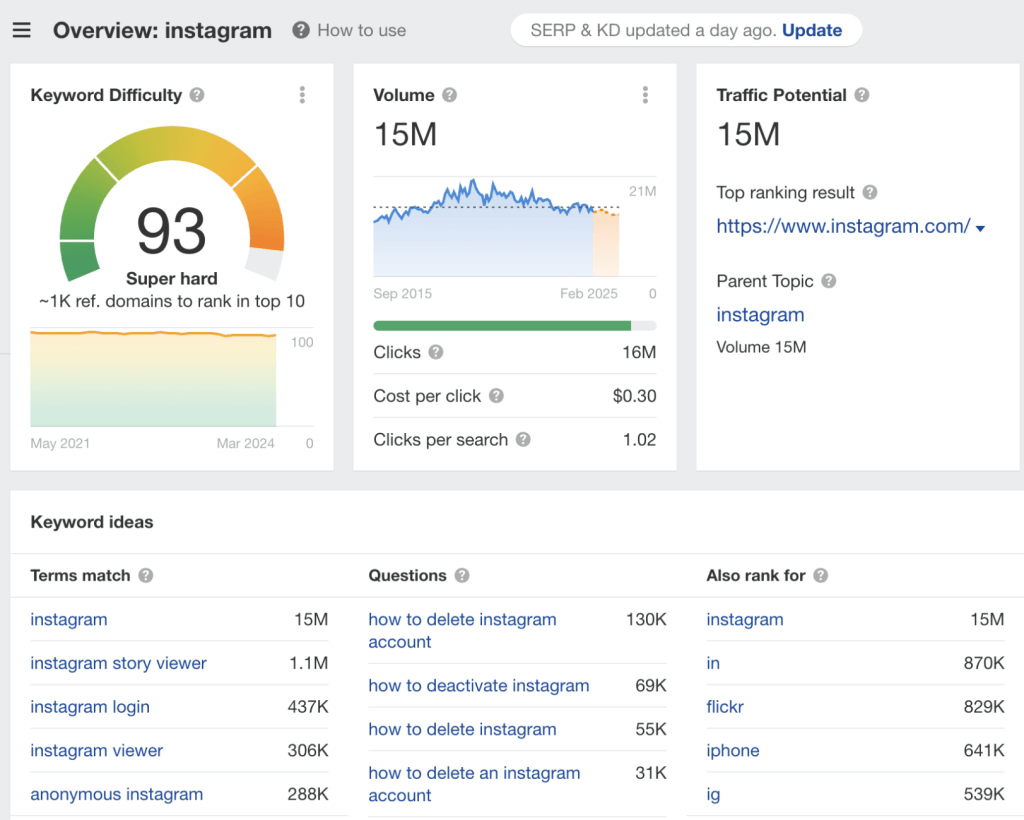
Here are a few ways you can use SEO tools to track brand awareness:
- Collect search volume data for branded keywords using Ahrefs: This gives you insights into how many times per month users are specifically searching for your brand. You can drill down the results by the search engine (Google or anything else, country, and so on.
- Track backlinks using Ahrefs: Look at backlinks using your brand name as the anchor for brand awareness relevancy.
- Understand organic with Google Analytics and Google Search Console: Search data is important for your brand awareness analysis as it tells you how much traffic your branded keywords generate.
The more people typing your brand name in search engines or linking to you, the better. It means they’re specifically looking for your products or recommending them.
How to track brand awareness changes over time
We’ve gone over some of the best ways to measure brand awareness. Now, let’s look at how you can track changes over time.
Following this process will help you understand how efficient your marketing strategies are at building brand awareness.
Step 1: Benchmark your historical data
Whether you are just starting out or already have strong brand awareness, it’s important to benchmark your data before anything.
No universal data can tell you if you have a strong brand awareness. It’s best to monitor and understand its evolution over time.
Write down your top KPIs and benchmark your starting point. We’ll cover which brand awareness KPIs are important later.
First, let’s move on to step two.
Step 2: Compare your brand awareness with competitors
Analyzing your data and comparing it with your top competitors can provide valuable insights into your market position at any given moment.
It will also help you identify relevant platforms and determine where your brand awareness strategy should focus. For example, if you are just starting out but have well-established competitors, you can find out where their brand is most frequently mentioned.
Once you’ve benchmarked your data and understood the top platforms where you should invest your efforts into, the next step is to track changes over time.
Step 3: Use tools to track brand awareness campaign attribution
It’s important to track all this data to understand each campaign’s impact on brand awareness.
Here are a few tools you should be looking at when tracking your data:
- Google Analytics: Understand the impact your brand awareness campaigns have on direct and organic traffic to a homepage by tracking campaign UTM tags.
- Google Search Console: Conduct keyword research to understand changes in branded keywords that drive traffic to your website.
- Social media monitoring tools like Hootsuite: Get analytics data on the use of branded hashtags and overall mentions across different social media platforms.
- Mention or Brand24: Track mentions of your brand over time.
Each of the tools we mentioned will give you relevant insights and pre-built analytics reporting. You can generate monthly reports from each or automate more advanced reports by combining data from multiple sources.
The latter option will give you a comprehensive 360-degree view of your brand awareness efforts.
You can keep track of all your brand awareness metrics inside a report or dashboard in Google Sheets, Looker Studio, or another solution. Simply add data from Google Analytics, Google Search Console, Facebook Ads Manager, or other platforms where you invest your brand awareness budget.
Let’s look at a few ways to measure brand awareness.
How to measure brand awareness campaign impact
As mentioned earlier, most marketing tools come with pre-built analytics.
For example, when your brand awareness strategy is focused on Instagram, you can use Instagram insights to collect data on how your campaigns impact brand awareness.
The downside is that digital marketing works best when you don’t focus only on one platform. The best results will come when your brand awareness efforts are spread across the most used channels among your target audience.
Generating reports from each can be time-consuming and might cause you to miss essential insights when analyzing data for each platform separately.
Here are a few ways to measure brand awareness campaign impact the right way.
Set up a reporting dashboard using a Looker Studio template
Looker Studio reports are great when you’re trying to analyze aggregated data. You can combine data from multiple data sources and visualize it using graphs and charts.
What’s great about Looker Studio when measuring brand awareness is that it offers you a blank canvas to create the most relevant reports. You can build these from scratch or use a template, then connect your data sources.
Using a Looker Studio template will save you time and might also give you ideas about how best to track your campaign’s impact on brand awareness.
Let’s look at an example.
If you run Facebook ads to increase brand awareness, you can start monitoring the relationship between your ad impressions and branded keyword searches. This ready-to-use Facebook Ads & Brand Awareness dashboard will be quite helpful for that.

You can easily track the impact of all your campaigns or filter by specific ones.
This template provides a quick summary of important metrics from Facebook Ads Manager and Google Search Console, including Impressions, Ad Clicks, Branded Clicks, and more, over time.
You can easily set this dashboard up in under 3 minutes:
- Create a Coupler.io account, then follow the steps inside the template to add an automated data integration. If you are already a Coupler.io user, you’ll be directed to the importer.
- Connect Google Search Console and Facebook Ads account one by one, following a quick setup wizard.

- Click Proceed to preview the data before adding it to your report. No actions are needed here.

- Click Proceed and follow the in-app instructions to authorize the connector and create a data source in Looker Studio.

- Once your connection is set, click the Create report button to populate the Looker Studio template with your data.

You will be redirected to the copy of the brand awareness report with your data. By default, the dashboard will be updated automatically every day. However, if you want to have a more frequent data refresh, go back to Coupler.io and tweak the schedule to your liking.
Note: Different intervals are available based on your pricing plan.

Bookmark your new brand awareness dashboard to always have these insights at your fingertips. You can also update this template by switching the data source from Facebook Ads to Google Ads, Twitter Ads, or another ad platform where you spend the most of your budget.
Create Google Analytics reports for each campaign
This can be tricky as it’s difficult to understand the dependencies between brand awareness campaigns based solely on Google Analytics data.
It’s still worth mentioning GA reporting, considering that Google Analytics is the main tool many companies use to track digital marketing’s impact on business growth.
Google Analytics is a tool that can help you analyze your website traffic based on various sources.
To understand how specific campaigns impact your brand’s awareness, you can track the traffic spikes generated by a campaign and compare them to the increase in direct or organic traffic to the homepage. This will help you determine whether the campaign has had a similar impact on both types of traffic.
You can create a Free-form explore report in GA4 and compare Direct traffic vs Paid traffic.
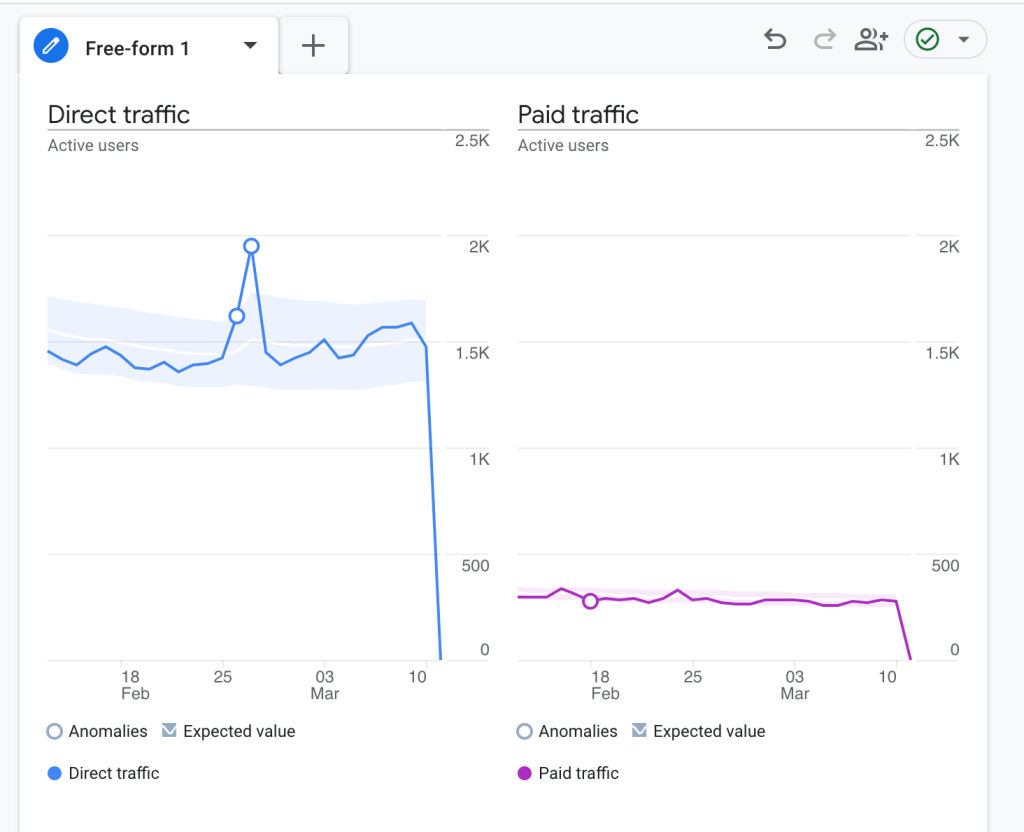
Track ad recall metrics on YouTube or Facebook
Tracking marketing campaigns can be easy in general. You look at impressions, clicks, and, ultimately, sales generated. However, measuring the impact on brand awareness isn’t as straightforward.
You can’t say that high impressions alone translate into increased brand awareness.
Here’s where the ad recall metric can make a difference.
Ad recall lift Facebook campaigns
Facebook’s ad recall metric is available for campaigns with page post engagement, video views, or brand awareness objectives.
Facebook’s estimated ad recall lift metric gives advertisers an idea of how many people would recall seeing their ad if asked about it within two days. Facebook suggests this metric indicates how well an ad resonates with its intended audience. And you can run ad recall lift campaigns to improve this.
To calculate this metric, Facebook uses machine learning to analyze behavior and event likelihood and pool data that asks users if they remember seeing an ad from your brand.
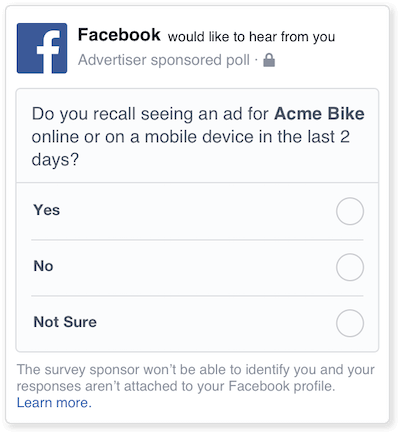
You can also consider getting a brand lift study for a more accurate ad recall measure. These studies use more in-depth tools to determine how well your ads resonate with your audience. You’ll need to contact a Facebook representative to see if your brand is eligible.
Brand Lift studies on YouTube
On YouTube, you can run Brand Lift studies for video campaigns. What are these?
Brand lift studies are short surveys targeted at two groups: those exposed to your ad and those not.
By asking these two groups the same question about your ad, you can easily understand if it made an impact.
Brand Lift will also measure how much interest your campaign generates in your brand by monitoring organic searches on Google.com and YouTube.
It measures your campaign’s impact on your brand’s interest by comparing the organic search behavior of a group that saw your ad and a control group that didn’t. The difference in searches can be attributed to your campaign.
Many of your brand awareness campaigns will be launched on social media platforms since those are great for starting conversations and driving engagement with your brand.
Each social media platform has its own analytics where you can track different metrics. If you’re using a social media scheduling tool, you will also have access to more aggregated analytics.
For example, Later, a social media management tool, includes detailed hashtag analytics.
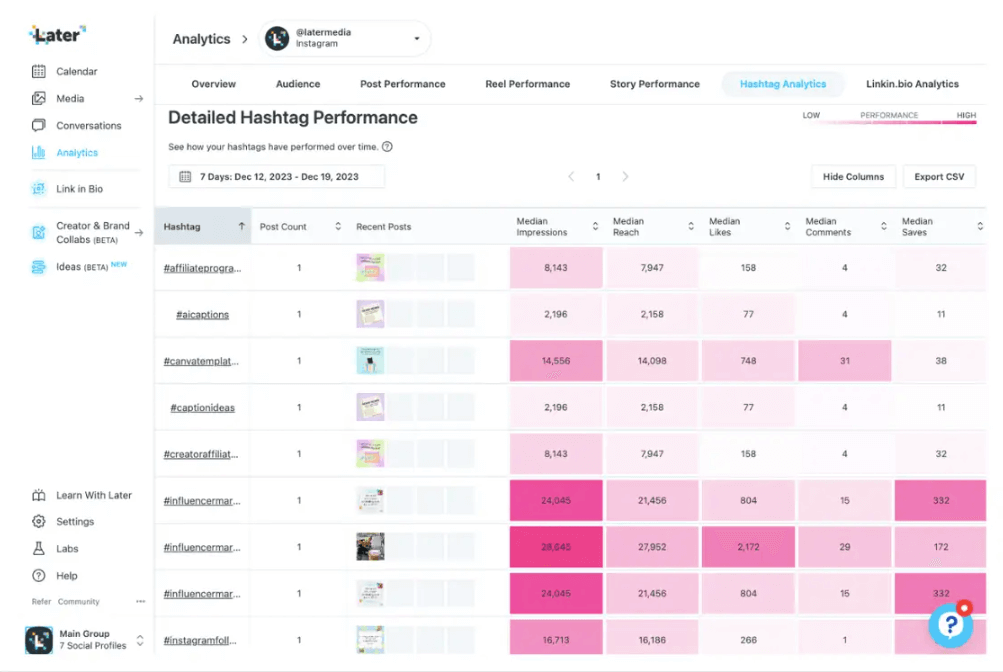
It’s worth noting that tracking impressions or reach alone isn’t enough to understand the impact your campaign has on your brand awareness.
We’ll look at the top metrics you should be tracking shortly. Before we do that, it’s important to remember that brand awareness is measured through a series of metrics.
It’s not enough to look at your brand hashtag usage over time or the overall engagement your brand awareness campaigns get.
Of course, an increase in these metrics over time can signal an increase in brand awareness. But you should always take these with a grain of salt.
Top brand awareness metrics and KPIs every marketer should track
We’ve covered the main things you should know about tracking brand awareness and what are some helpful tools.
Let’s look at some important metrics to measure brand awareness that give you insights into the level of brand awareness your campaigns are driving.
Social media reach and impressions
Social media reach refers to the number of people exposed to your paid or organic posts, while impressions is a metric that counts the number of times your posts are seen.
What do these have to do with brand awareness?
These metrics are not an exact science for measuring brand awareness but can be a good indicator. Think of it like this: The more often someone sees elements of your brand in their daily life, the more likely they are to remember you.
Social media engagement
Social media engagement is any interaction users have with your posts, such as likes, comments, or shares.
When potential customers engage more often with your content, it’s a sign that your message aligns with their values, wants, or needs. They are not only aware of your brand but also understand and agree with what it stands for.
It also indicates what type of content can help you spread the word about your brand after. More engagement means social media platforms will find your content relevant and will organically increase your post’s reach.
You should also keep an eye on potentially negative engagement, such as dislikes, negative comments, or a lack of engagement altogether.
People not engaging with your content might indicate poor brand awareness, while negative comments can signal distrust in your brand.
This can impact your brand reputation in the long term. You should look into fixing that before amplifying your brand awareness efforts.
Social media sentiment score
Similar to what we mentioned above, a sentiment score measures the positive or negative impact of your social media engagement.
This doesn’t consider only comments but also brand mentions and the content of the post in which it happened.
A social media sentiment analysis will give you an overall picture of how people perceive your brand. Social listening tools like Brand24 automatically calculate this score based on the frequency of positive and negative language used by the audience engaging with your brand.
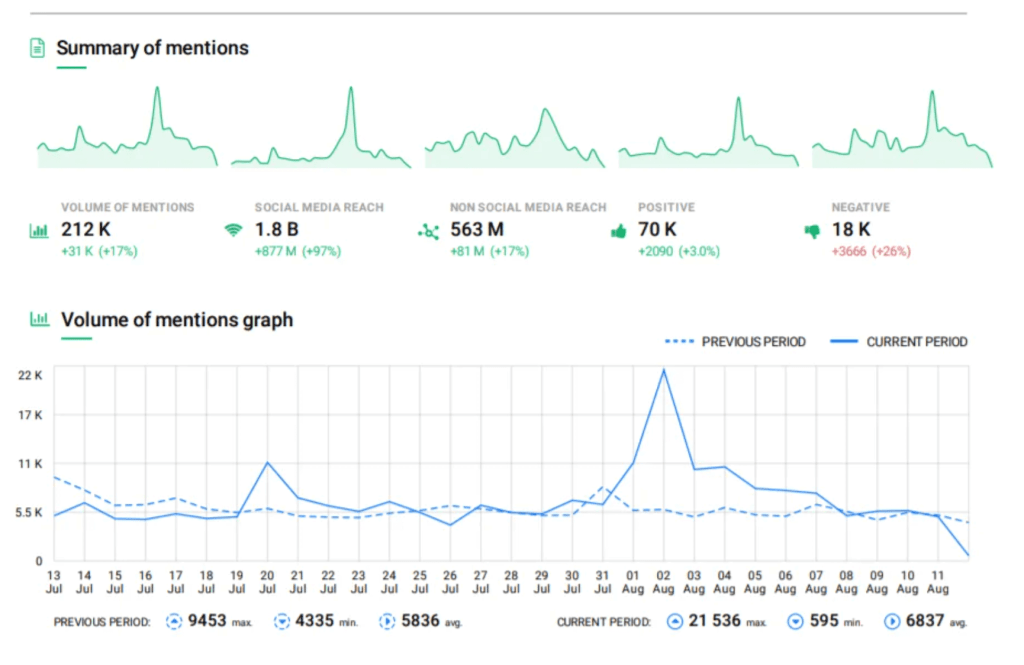
If your brand sentiment score is below 50%, your brand is negatively perceived. You should try to understand what is causing this before increasing brand awareness.
Review customer satisfaction surveys and interviews, talk to your customer support team, or analyze churn reasons.
Brand mentions on social media refer to how many times your brand has been tagged in other people’s posts. These could be paid brand mentions from influencer or promoter campaigns or good old-fashioned word-of-mouth – happy customers recommending your brand.
You can include hashtag usage as a brand mention if you’ve created your own. This indicates how many people know your brand name and values and are happy to be associated with it.
Among numerous brand awareness metrics, the share of voice (SOV) is a way to measure your brand’s share of the market compared to your competitors.
For example, if your brand received 100 social media mentions out of a total of 1000 mentions for all brands in its category, your SOV would be 10%.
SOV is best measured across separate social media channels. For example, you might want to know if your brand is stronger on LinkedIn than on Twitter.
For a more in-depth brand awareness measurement, go beyond social media. Track your SOV across different types of content.
In the context of brand awareness, you will want to look at branded organic traffic.
To calculate SOV for that, use this formula:
Your branded share of voice= branded organic traffic/ total market branded organic traffic x 100.
To simplify this, keep track of this metric against your top competitors over time.
Branded search volume
Branded search volume is a metric that tells you how many times specific queries that include your brand names are being used in organic searches monthly.
There is no way of accurately tracking these, but you can use SEO tools like Ahrefs to get estimates on these numbers.
Track changes over time and try to identify if there’s any correlation between spikes in search volume and specific brand awareness campaigns. This will give you a good indication of how successful your brand awareness efforts are.
Direct and organic traffic to the homepage
Direct website traffic measures the sessions for two cases:
- when users directly type in your branded queries in their browsers
- when web analytics platforms can’t define where the traffic comes from.
Organic traffic is all traffic coming to your website from search queries across different search engines such as Google, Bing, etc.
To measure brand awareness, you need to look particularly at the combination of direct and organic traffic to your homepage.
When direct traffic to the homepage grows, this means the awareness of the brand domain goes up as well. Therefore, users just type your brand name in their browsers.
When organic traffic to the homepage grows, this is mostly because of the growing number of branded searches in search engines.
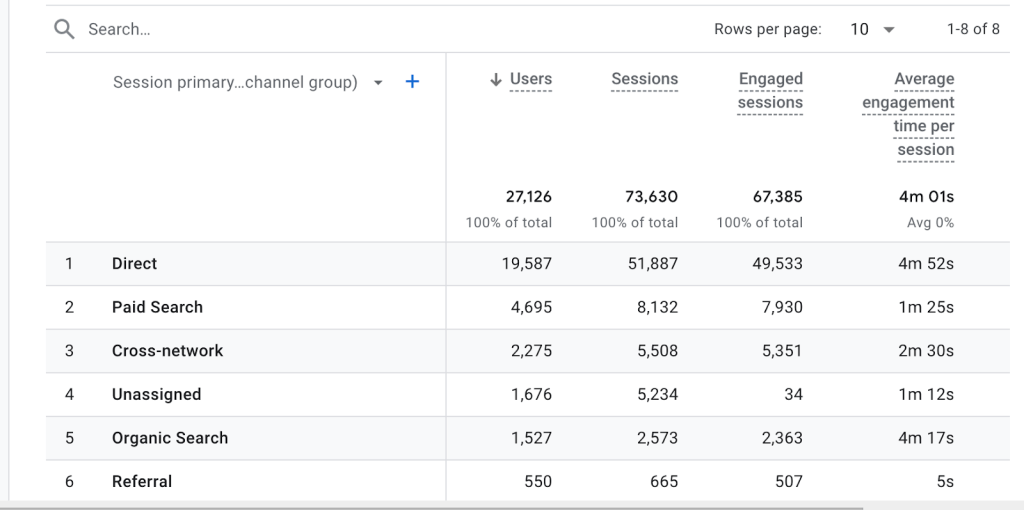
Referral traffic
On the other hand, referral traffic measures the total traffic coming to your website through another source.
These will be links to your website shared on social media and displayed in your Google Analytics dashboard. You can also add another dimension and look at session source at the same time.
Referral traffic is a good KPI for brand awareness, as it is similar to brand mentions. The more people mention your brand and link to it, the more awareness there is of it.
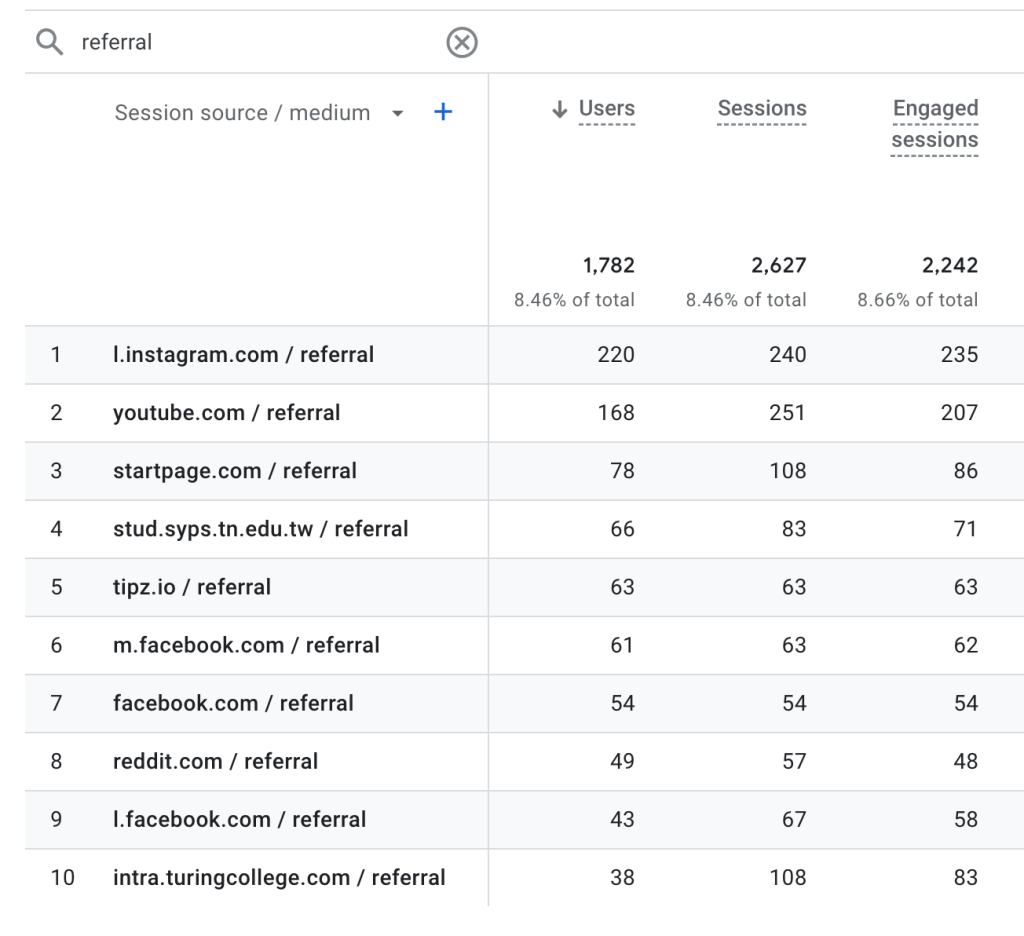
Note: When checking this metric, make sure to validate the domains that are sending you referral traffic. For example, look for relevant domains that are promoting your brand without getting compensation in return.
Earned media coverage
Earn media coverage refers to third-party content written and published about your brand that you haven’t paid for or created in-house.
This could be online newspapers, tweets, print articles, podcasts, etc.
Do not confuse earned media with owned or paid media.
For example, launching an influencer brand awareness campaign and paying the influencer a fee for posting and mentioning your brand will qualify as paid media.
Tips for increasing brand awareness
We’ve covered how to measure brand awareness and which are the most important metrics to track.
Let’s quickly review some best practices and strategies for increasing brand awareness.
Create paid ads brand awareness campaigns
Paid brand awareness campaigns will help you increase paid media mentions.
Depending on the channel your target audience is and available budget, you could be looking at:
- Paid social media influencer campaigns: Can drive brand mentions and engagement but can be expensive depending on how popular the influencer is and the niche of your product.
- Branded paid traffic: Running Google Ads on branded keywords is a way to keep competitors from getting traffic from your brand search. These campaigns are usually inexpensive since your domain has the highest keyword relevancy.
- Paid demand generation campaigns: Promoting your webinars, in-depth research studies or other demand generation content can help enhance your brand awareness efforts. Paid advertising can contribute to this since you can refine ad campaigns based on specific demographics, interests, or behaviors. As a result, you can reach a wider audience that will boost your lead gen efforts, and spread awareness of your brand on multiple channels.
Viral marketing loops are similar to word of mouth as they are also impacted by a great product and experience.
A viral loop happens when you create a valuable product or service that customers are willing to share it with their friends.
Viral marketing loops come in different forms:
- Referral programs: Paying users a flat fee in exchange for sharing your product with their friends.
- Affiliate programs: Paying influencers or relevant people in your industry a sales commission to encourage signups.
- Freemium subscriptions: These give users access to use your product for free in exchange for branding the outputs. For example, Calendly offers a free plan, but every time you share your link, the brand logo is visible, and people are encouraged to create an account after successfully setting up the call.
Encourage word-of-mouth
Word of mouth (WOM) refers to brand mentions and recommendations. The more people share their experiences with your brand, the greater the impact on brand awareness.
It should go without saying that a great customer experience will drive WOM organically.
That doesn’t mean you can’t also encourage it.
Timing is crucial here. For example, try asking a customer to leave you a G2 review after interacting positively with your customer support staff. Or even offer vouchers or subscription discounts in exchange for an in-depth review.
Leverage public relations (PR)
When you have important news about your brand, you can use PR content to reach a wide and relevant audience. For example, has your SaaS business just received new funding or acquired a different brand?
That is a great moment to leverage the positive news to generate brand awareness.
PR websites and agencies can help you reach large audiences with your message. You can also share PR content through your owned platforms to increase your reach.
Keep your brand message and tone of voice consistent
Last but not least, when looking to increase brand awareness, consistency is key.
Brand awareness is a result of people being exposed to your brand and remembering it.
If your message, brand image, or voice is not consistent, then it will be difficult for people to associate your brand with the media they are exposed to in the long run.
How to measure brand awareness efficiently
We’ve covered a lot in this comprehensive guide on measuring brand awareness.
If there’s one key point to remember, that would be that there isn’t a universal tool that can measure brand awareness.
To properly track your efforts, you need to look at specific metrics individually and simultaneously based on your content marketing campaigns.
Start with the analytics functionalities of your preferred marketing tools. As your campaigns grow, you might want to bring all that data inside tools like Looker Studio for a more comprehensive analysis across multiple channels. Already there?
Automate data export with Coupler.io
Get started for free




